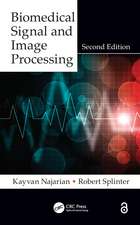Physiology for Engineers: Applying Engineering Methods to Physiological Systems: Biosystems & Biorobotics, cartea 13
Autor Michael Chappell, Stephen Payneen Limba Engleză Hardback – 4 dec 2015
| Toate formatele și edițiile | Preț | Express |
|---|---|---|
| Paperback (2) | 406.56 lei 38-44 zile | |
| Springer International Publishing – 29 mar 2019 | 406.56 lei 38-44 zile | |
| Springer International Publishing – 29 apr 2021 | 448.30 lei 6-8 săpt. | |
| Hardback (2) | 702.15 lei 6-8 săpt. | |
| Springer International Publishing – 28 apr 2020 | 702.15 lei 6-8 săpt. | |
| Springer International Publishing – 4 dec 2015 | 823.01 lei 38-44 zile |
Din seria Biosystems & Biorobotics
-
 Preț: 121.79 lei
Preț: 121.79 lei - 5%
 Preț: 2086.52 lei
Preț: 2086.52 lei - 5%
 Preț: 709.65 lei
Preț: 709.65 lei - 5%
 Preț: 723.48 lei
Preț: 723.48 lei - 5%
 Preț: 701.10 lei
Preț: 701.10 lei - 5%
 Preț: 406.56 lei
Preț: 406.56 lei - 15%
 Preț: 629.19 lei
Preț: 629.19 lei - 5%
 Preț: 3238.02 lei
Preț: 3238.02 lei - 5%
 Preț: 1088.01 lei
Preț: 1088.01 lei - 5%
 Preț: 1378.95 lei
Preț: 1378.95 lei - 5%
 Preț: 824.50 lei
Preț: 824.50 lei - 5%
 Preț: 1278.10 lei
Preț: 1278.10 lei - 15%
 Preț: 623.11 lei
Preț: 623.11 lei - 5%
 Preț: 1402.60 lei
Preț: 1402.60 lei - 20%
 Preț: 639.53 lei
Preț: 639.53 lei - 18%
 Preț: 1188.25 lei
Preț: 1188.25 lei - 5%
 Preț: 693.90 lei
Preț: 693.90 lei - 5%
 Preț: 1896.71 lei
Preț: 1896.71 lei - 5%
 Preț: 2840.23 lei
Preț: 2840.23 lei - 5%
 Preț: 1070.63 lei
Preț: 1070.63 lei - 5%
 Preț: 699.11 lei
Preț: 699.11 lei - 18%
 Preț: 1190.87 lei
Preț: 1190.87 lei - 5%
 Preț: 710.77 lei
Preț: 710.77 lei - 5%
 Preț: 707.53 lei
Preț: 707.53 lei - 5%
 Preț: 696.42 lei
Preț: 696.42 lei - 5%
 Preț: 2101.62 lei
Preț: 2101.62 lei
Preț: 823.01 lei
Preț vechi: 866.32 lei
-5% Nou
Puncte Express: 1235
Preț estimativ în valută:
157.55€ • 164.01$ • 129.71£
157.55€ • 164.01$ • 129.71£
Carte tipărită la comandă
Livrare economică 28 ianuarie-03 februarie 25
Preluare comenzi: 021 569.72.76
Specificații
ISBN-13: 9783319261959
ISBN-10: 3319261959
Pagini: 167
Ilustrații: XIV, 167 p. 71 illus., 27 illus. in color.
Dimensiuni: 155 x 235 x 18 mm
Greutate: 4.03 kg
Ediția:2016
Editura: Springer International Publishing
Colecția Springer
Seria Biosystems & Biorobotics
Locul publicării:Cham, Switzerland
ISBN-10: 3319261959
Pagini: 167
Ilustrații: XIV, 167 p. 71 illus., 27 illus. in color.
Dimensiuni: 155 x 235 x 18 mm
Greutate: 4.03 kg
Ediția:2016
Editura: Springer International Publishing
Colecția Springer
Seria Biosystems & Biorobotics
Locul publicării:Cham, Switzerland
Public țintă
GraduateCuprins
Cell structure and biochemical reactions.- Cellular homeostasis and membrane potential.- The action potential.- Transport and cell-cell transmission.- Pharmacokinetics.- Skeletal-Muscular System.- Cardiovascular system I: The heart.- Cardiovascular system II: The vasculature.- Respiratory system.- Nervous system.
Notă biografică
Prof. Chappell came to biomedical engineering by accident having done a general engineering degree before
biomedical engineering was a separate option. Having spent some time modelling bubbles in the bloodstream
and using imaging to measure perfusion and pH in the brain he has found that engineering is a great
foundation for taking a quantitative view of physiology and thus contributing to medical research as a
biomedical engineer.
Dr Payne has worked in physiological modelling for over 10 years, with particular interests in blood flow in
the brain and heat treatment of cancer. Having entered the field of biomedical engineering before it was
available even as an undergraduate option course, he has seen first-hand how difficult it can be to learn about
physiology in a way that makes it amenable to mathematical treatment, such as mathematical modelling,
without good introductory guides.
biomedical engineering was a separate option. Having spent some time modelling bubbles in the bloodstream
and using imaging to measure perfusion and pH in the brain he has found that engineering is a great
foundation for taking a quantitative view of physiology and thus contributing to medical research as a
biomedical engineer.
Dr Payne has worked in physiological modelling for over 10 years, with particular interests in blood flow in
the brain and heat treatment of cancer. Having entered the field of biomedical engineering before it was
available even as an undergraduate option course, he has seen first-hand how difficult it can be to learn about
physiology in a way that makes it amenable to mathematical treatment, such as mathematical modelling,
without good introductory guides.
Textul de pe ultima copertă
This book provides an introduction to qualitative and quantitative aspects of human physiology. It looks at biological and physiological processes and phenomena, including a selection of mathematical models, showing how physiological problems can be mathematically formulated and studied. It also illustrates how a wide range of engineering and physics topics, including electronics, fluid dynamics, solid mechanics and control theory can be used to describe and understand physiological processes and systems. Throughout the text there are introductions to measuring and quantifying physiological processes using both signal and imaging technologies. Physiology for Engineers describes the basic structure and models of cellular systems, the structure and function of the cardiovascular system, the electrical and mechanical activity of the heart and provides an overview of the structure and function of the respiratory and nervous systems. It also includes an introduction to the basic concepts and applications of reaction kinetics, pharmacokinetic modelling and tracer kinetics. It is of interest to final year biomedical engineering undergraduates and graduate students alike, as well as to practising engineers new to the fields of bioengineering or medical physics.
Caracteristici
Provides a set of thoroughly classroom-tested exercises and worked examples for student readers Offers an accessible introduction to physiology for physical sciences and engineering students, building on concepts with which they are already familiar Focuses on engineering methods and their application to a range of physiological systems Includes supplementary material: sn.pub/extras











